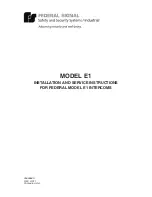
As at 09/07
8
Chapter 4: Binary inputs
4.2
Binary inputs, 4-gang
Binary input REG-K/4x24
Multi-function.counter 12BA/1.0
Art. no. 644892
A description of the most important actions is given
below:
– transmits [value]:
transmits the current value and stops a cyclical
transmission.
– transmits [value] immediately and then cyclically:
If no cycle time is running, [value] is transmitted im-
mediately and a new cycle time is started. If a cycle
time is already running, this is interrupted, [value] is
transmitted and a new cycle time is started.
– transmits [value] only cyclically:
If no cycle time is running, [value] is transmitted im-
mediately and a new cycle time is started. If a cycle
time is already running, this is
not
interrupted, [va-
lue] is transmitted after the current cycle time has
elapsed, and a new cycle time is started.
– sets object value to [value] (readable only)
[value] is written into the object and is not transmit-
ted An active cycle time is terminated.
– toggles:
compares the current object value with [value]. If
both are the same, value 1 or value 2 is transmitted.
If both are different, [value] is transmitted.
– toggles, transmits immediately, then cyclically:
The value is toggled (see "toggles") if no cycle time
is running, transmitted immediately and a new cycle
time is started. If a cycle time is already running,
this is interrupted, the toggled value is transmitted
and a new cycle time is started. Subsequently, the
value which has already been toggled is always
transmitted cyclically.
– toggles, only transmits cyclically:
If no cycle time is running, the toggled value is
transmitted immediately and a new cycle time is
started. If a cycle time is already running, this is
not
interrupted, the toggled value is transmitted after
the current cycle time has elapsed, and a new cycle
time is started. Subsequently, the value which has
already been toggled is always transmitted cyclical-
ly.
– toggles and is not transmitted:
The toggled value is written into the object and is
not transmitted. An active cycle time is terminated.
– toggles cyclically, transmits immediately, then cycli-
cally:
The value is toggled (see "toggles") if no cycle time
is running, transmitted immediately and a new cycle
time is started. If a cycle time is already running,
this is interrupted, the toggled value is transmitted
and a new cycle time is started. It is always subse-
quently cyclically toggled, and the new value is
transmitted.
– toggles cyclically, only transmits cyclically:
If no cycle time is running, the toggled value is
transmitted immediately and a new cycle time is
started. If a cycle time is already running, this is
not
interrupted, the toggled value is transmitted after
the current cycle time has elapsed, and a new cycle
time is started. It is always subsequently cyclically
toggled, and the new value is transmitted.
– toggles cyclically and is not transmitted:
The toggled value is written into the object and is
not
transmitted. It is always subsequently cyclically
toggled, and the new value is written into the ob-
ject.
– transmits its value:
The current object value is transmitted. An active cy-
cle time is terminated.
– sends its value immediately and then cyclically:
If no cycle time is running, the current object value
is transmitted immediately and a new cycle time is
started. If a cycle time is already running, this is in-
terrupted, the current object value is transmitted
and a new cycle time is started. Subsequently, the
current object value is always transmitted cyclically.
– increase the current object value by [value] cyclical-
ly:
If no cycle time is running, [value] is added to the
current object value, the object value is transmitted,
and a new cycle time is started. If a cycle time is al-
ready running, this is
not
interrupted, the current
object value with [value] added is transmitted and a
new cycle time is started.
– reduce the current object value by [value] cyclically:
If no cycle time is running, [value] is subtracted from
the current object value, the object value is trans-
mitted, and a new cycle time is started. If a cycle
time is already running, this is
not
interrupted, the
current object value with [value] subtracted is trans-
mitted and a new cycle time is started.
– transmits [valueA] and after a cycle time [valueB]:
[ValueA] is transmitted immediately, and [valueB] is
transmitted after
one
cycle time, regardless of whe-
ther a cycle time is already running or not (staircase
timer function).
– none (stops cyclical transmission):
No action is carried out, and any active cycle time is
stopped.
– no change:
The current action remains unchanged (e. g. "trans-
mits value1 and after a cycle time, transmits
value2").
– none (stop after current cycle time has elapsed):
No action is currently carried out, but any active cy-
cle time is
not
stopped. It runs through until the
end, and then transmits the corresponding value.
Examples of use for the pulse edge function
The following activation sequence diagram shows the
phases into which the pulse edge function is divided:
t
press
release
long activation time
action direct
at pressing
button
action at arrive of
long activation time
action at release
after arriving long
activation time
action at release
before arriving long
activation time







































